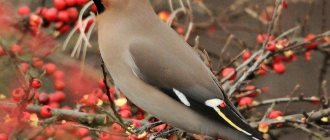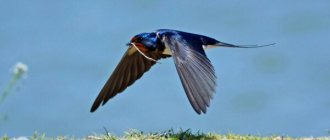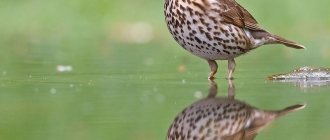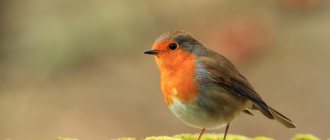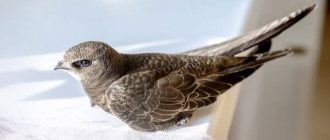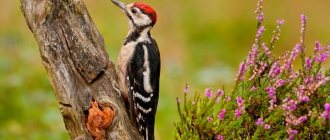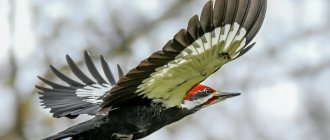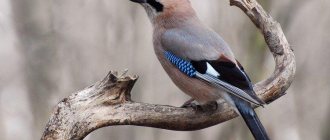- Wild animals
- >>
- Birds
The hoopoe is a small but quite memorable bird with bright plumage, a narrow elongated beak and a fan-shaped crest.
Belongs to the family Upupidae (hoopopods). There are many beliefs associated with the bird. In Russia, his cry was perceived as the phrase “It’s bad here!”, which was considered a bad omen. In the south of Russia and Ukraine, the cry of a hoopoe was correlated with the beginning of rain. Caucasian legends spoke of the appearance of a crest in birds. “One day the father-in-law saw his daughter-in-law combing her hair. Out of shame, the woman wanted to turn into a bird, and the comb remained in her hair.
Description of the bird
The body length of the hoopoe is from 25 to 29 cm, the wingspan is 44-48 cm. On the head there is a characteristic crest of feathers, orange-red in color with black feather tips. It is 5 to 10 cm long and is usually folded, but when landing, the hoopoe spreads it into a fan shape. The head, neck and chest vary among subspecies from pink to chestnut color. The wings are wide, rounded, with black and whitish-yellow stripes. The tail is medium length, black with a white stripe. The belly is pinkish-red, with black longitudinal stripes on the sides. The beak is long, about 4-5 cm, thin, curved. The paws are lead-gray, strong, with blunt claws. Males and females look the same. Juveniles are not as bright as adults, and their beak and crest are shorter.
Shedding
Molting occurs in nesting areas. During this, the flight and tail feathers are changed. Small feathers are usually replaced during wintering. In birds living in Central Asia, molting begins in mid-July and ends in November; in young animals in this area, molting occurs from August to September. Due to the extended breeding season, young individuals can be seen in autumn plumage as early as late August.
The flight feathers begin to change from the middle to the edge, and the tail feathers vice versa. The small feather changes from the crest, then from the neck to the back. Hoopoes that go through the molt are well-fed and do not lose weight.
What does it eat?
— Advertising —
The hoopoe feeds on small invertebrate animals: insects, their larvae and pupae (chafer beetles, dung beetles, carnivores, grasshoppers, butterflies, steppe fillies, flies, ants, termites), spiders, woodlice, centipedes, as well as small mollusks. Sometimes birds include amphibians and reptiles in their diet, for example, frogs, lizards, and snakes.
The hoopoe looks for food on the surface of the ground, in short grass or on bare ground. The long beak allows the bird to pick through manure, garbage heaps, rotten wood, and make shallow holes in the ground. In addition, the hoopoe can find food near grazing livestock. Due to its short tongue, the hoopoe cannot always swallow prey from the ground, so first it throws it into the air, and then catches and swallows it. The hoopoe breaks large beetles into pieces by hammering them on the ground.
Lifestyle and features
The hoopoe is more active during the daytime. This bird lives both on land and in trees. The hoopoe walks quickly, but flies slowly, its movements in the air are wave-like. The bird likes to sit for a long time on cliffs, tree branches and abandoned buildings. This representative of the hoopoids nests in hollows.
Hoopoes can live either alone or in pairs. When the female incubates the eggs, the male searches for food. He looks for food better after the chicks hatch, because now he is forced to feed the whole family. In semi-deserts, during this period the male is active both day and night. Somewhere in the middle of the day, invertebrates become more passive, and “hunting” becomes more difficult. In summer, in hot weather, the male tries not to leave the shade. He also lies down in a hole and spreads his wings. During the incubation period, mothers sometimes leave for an hour to three hours; after the chicks hatch, they leave for an even shorter period. On hot days the female does not leave the nest.
Hoopoes live close to their relatives; they live in small areas where they coexist with the little owl and the roller. However, this does not mean that hoopoes are social birds.
Where does it live?
— Advertising —
In Eurasia, the hoopoe is found throughout the continent, from west to east, in the central and southern regions. The bird does not nest only in Great Britain, Belgium, Luxembourg, Scandinavia, as well as high in the Alps, Apennines and Pyrenees. Rarely lives in Germany and the Baltic states. In Russia, the hoopoe is distributed south of the Gulf of Finland, in the Novgorod, Yaroslavl, Nizhny Novgorod regions, the republics of Tatarstan and Bashkortostan, and in Siberia. In Asia, the hoopoe is widespread and is not found only in deserts and areas of continuous forest. The habitat of the hoopoe in Africa is located south of the Sahara, and along the coast of the Mediterranean Sea. In addition to the continents, the hoopoe also nests on the Japanese Islands, Taiwan, Madagascar, and Sri Lanka.
Depending on their habitat, there are sedentary, nomadic and migratory hoopoes. Most of the population migrates to the central and southern regions of Africa for the winter. A small number of hoopoes spend the winter in the Mediterranean region, or northern Africa. Birds from Central Asia and Siberia fly to the south of the continent. The timing of migration is also variable. In the spring, hoopoes return from February to May, and in the fall they fly away from mid-July to the end of October.
Hoopoes prefer to live on plains or in hilly areas, in open landscapes without tall grass, but with isolated trees or groves. In the mountains it lives at an altitude of up to 2000 m above sea level. The most convenient for birds are the steppe and forest-steppe zones, and savanna. Hoopoe is also found near humans (pastures, vineyards, orchards). Within populated areas it can live to feed in garbage dumps.
The hoopoe nests in hollow trees, crevices in stones, holes in river cliffs, termite mounds, and recesses in stone buildings.
Maned or Nicobar pigeon (Caloenas nicobarica)
It is an exceptionally beautiful but not very well known species found in the Nicobar Islands of the Bay of Bengal. With iridescent green feathers, the maned dove can be called the most beautiful pigeon in the world. It also has long green-blue feathers on its upper neck.
These long neck feathers give the Nicobar pigeon its hair-like appearance. This also gives them a unique appearance. Compared to males, female Nicobar pigeons are small and brownish in color.
Common types
The hoopoe is the only living bird species that belongs to the hoopoe family (Upupidae). Depending on the size, color of plumage and shape of the wings of the bird, the following subspecies are distinguished:
Upupa epops epops (common hoopoe)
A resident of Eurasia, it is found everywhere from the Atlantic to China, as well as in the Canary Islands, Madeira Island and northwest Africa.
Upupa epops major
Breeds in Egypt, northern Sudan and eastern Chad. The largest subspecies with a long beak, gray back and a narrow stripe on the tail.
Upupa epops senegalensis (Senegalese hoopoe)
It lives in Algeria, in Africa from Senegal to Ethiopia and Somalia. Small subspecies. The wings are short, with white stripes.
Upupa epops waibeli
Found in Africa from Cameroon and Zaire to Uganda and northern Kenya. Painted in dark colors.
Upupa epops africana (African hoopoe)
Its habitat includes Africa from Zaire to Kenya. The plumage is dark red in color, without white stripes on the wings.
Upupa epops marginata (Madagascar hoopoe)
Endemic to the island of Madagascar. A large bird with pale plumage and narrow white stripes on the wings.
Upupa epops saturata
Distributed in Eurasia from Russia to the Japanese Islands and China. It is distinguished by its grayish back plumage and pale belly.
Upupa epops ceylonensis
A resident of Central Asia south of Pakistan and northern India, as well as Sri Lanka. Little red bird.
Upupa epops longirostris
Lives in India, Bangladesh, China. A large, dull subspecies with narrow stripes on the wings.
The hoopoe's closest relative is the forest hoopoe, a member of the tree hoopoe family.
Forest Hoopoe (Phoeniculus castaneiceps)
The bird's body length is up to 25 cm. The wings and tail are black without white spots, the head of the female is brown, the head of the male is brown, white or green with a shine. The beak is dark gray.
The species is distributed in the equatorial and tropical forests of Western, Central and Eastern Africa.
Himalayan monal (Lophophorus impejanus)
photo Peter Stubbs flickr.com
The Himalayan monal is a stunningly colorful bird endemic to the Himalayas. Males have a more colorful appearance than females. Their exceptionally beautiful plumage is a mixture of metallic blue, green, red and purple. The males of these birds also have noticeable metallic green feathers.
The female Himalayan monal does not have the stunning coloration of the males. They have the usual brownish plumage. Tufts on the head are also found in females, but they are small in size and brown in color.
Reproduction
The hoopoe is a monogamous bird. Reaches sexual maturity at the age of one year.
Mating season
Arrives at nesting sites in March or April. Males immediately occupy the nesting territory and behave extremely actively: they scream loudly and make repeated dull “whoop-whoop” sounds to call the females. Hoopoes scream most often and loudly during this period in the mornings and evenings. During courtship, the male and female fly after each other and choose a place for the nest. The couple usually uses the same territory for several years in a row.
Nest
Hoopoes build nests in secluded places, for example, in tree hollows, rocky crevices, recesses on cliff slopes, and occasionally in the walls of stone or clay buildings. If the birds do not find shelter, they lay eggs directly on the ground in the dried remains of the animal. Hoopoes do not line the nest from the inside, or they bring a little grass, feathers, or pieces of cow dung. In hollows, rotten wood dust serves as litter.
Hoopoes never remove droppings from the nest, and during nesting they secrete an oily liquid with a strong unpleasant odor. This protects the birds from land-based predators, but people call the hoopoe "unclean."
Laying eggs
There are from 5 to 9 eggs in a clutch, on average 4-7. The eggs are oblong, grayish-white or dark brown. The female lays one egg per day, but begins incubation from the first. The male does not participate in incubating the eggs; he obtains food for the female.
Chicks
The incubation period lasts 25-32 days. The chicks are born blind, covered in reddish down, which changes to pinkish-white and thick. Both partners feed the offspring with insects and worms. At the age of 20-27, the chicks leave the nest.
Natural enemies of hoopoes
Photo: Hoopoe on a tree
Hoopoes rarely fall prey to predators. Adapting to the behavior of enemies, hoopoes and their offspring have developed special forms of behavior. When a bird of prey suddenly appears and safe retreat to cover is impossible, hoopoes adopt a camouflage pose, creating an unusual body contour with such richly colored plumage. The bird lies down on the ground, spreading its wings and tail wide. The neck, head and beak point sharply upward. Mostly predators miss him in this motionless defensive position. Some researchers have recently seen this body position as a comfortable resting position.
Interesting fact: Chicks that are threatened by predators are also not defenseless. They hiss like snakes, and some older individuals deposit their excrement at the entrance to the cave as protection. Even when they are caught, they continue to resist intensely.
However, a particularly effective remedy against predator attacks is the secretion of an oily liquid with a very unpleasant odor from the pancreas. In the nest, the brooding female has very well developed defenses against predators. The coccygeal gland is rapidly modified to produce a foul-smelling substrate. The glands of chicks are capable of doing the same. These secretions are absorbed into the plumage. The fluid is released at regular intervals, and perhaps increases in situations of overstimulation.
The clutch, which smells like rotting meat, is thought to help keep predators at bay, as well as preventing the development of parasites and possibly having an antibacterial effect. Secretion stops shortly before the young leave the nest. In nature, hoopoes can be hunted by birds of prey, mammals, and are subject to devastation by snakes.
Voice
The hoopoe's voice is dull, guttural, and consists of three to five syllable calls “up-up-up” or “ud-ud-ud”, which are repeated several times in a row. The name of the bird is onomatopoeic to this song. A surprised or frightened bird emits a piercing cry “chii-eeer”, similar to the voice of a turtle dove. During the mating season or while courting chicks, hoopoes make dull, rolling sounds.
Only the Madagascar hoopoe differs from all subspecies in its voice; its song resembles a booming purr.
Golden Pheasant (Chrysolophus pictus)
photo Cuong Cao flickr.com
Native to Western and Central China, golden pheasants are one of the most beautiful birds in the world. The male is brighter in color than the female. The females are a dull brown color, while the male is a mixture of several bright colors.
Despite the multi-colored plumage, the fantastic crest can be called the most remarkable feature of the males of these pheasants. These long golden yellow crest feathers reach to the end of the neck.
When feathered on the body, the golden pheasant has red underparts, a bright yellow wattle, green upper back, goldfish and a long brown tail. Interestingly, the male golden pheasant's long tail accounts for two-thirds of its total length.
Interesting Facts
- The hoopoe moves quickly and nimbly across the surface of the earth. In case of danger, the bird presses to the ground, spreads its wings and tail and lifts its beak up.
- Hoopoes are found in many literary works and cultures of different peoples. Thus, in the mythology of Ancient Greece, a story is mentioned about how the Thracian king Tereus was turned into a hoopoe after attempting to kill his wives. Among the Ingush and Chechens, before the adoption of Islam, the hoopoe was a sacred bird, a symbol of the goddess of spring, fertility and childbirth. A hoopoe nest in the yard was considered a good omen. In Islam and Jewish sources there is an association of the hoopoe with King Solomon. And in the Torah and the Old Testament, the hoopoe is mentioned among the birds that are forbidden to be eaten.
Guinea turaco (Tauraco persa)
photo by Marilyn M. Bergman flickr.com
The Guinea turaco is a medium-sized bird with unusual plumage. This beautiful bird lives in savannas and forest areas of Africa. The turaco's plumage is green from head to chest. The back and tail are dark purple in color. But, the 2-inch long green crest is the most striking feature of the Guinea Turaco. Turakos display a full length of their feathers when warned.
Eastern crowned crane (Balearica regulorum)
The Eastern Crowned Crane is a large bird that lives in the swamps and grasslands of Eastern and Southern Africa. It is the National Bird of Uganda. This bird has mostly gray plumage and also has a unique crest.
Their wings are a mixture of black and white feathers. Probably the most attractive part is their crown or crest, which has beautiful golden feathers. They also have a bright red throat color.
